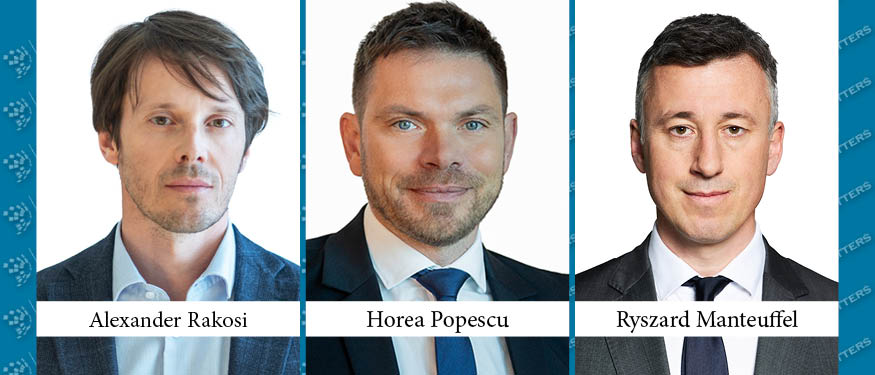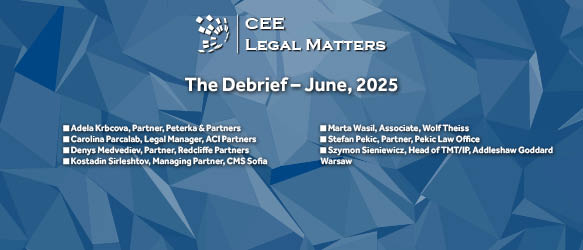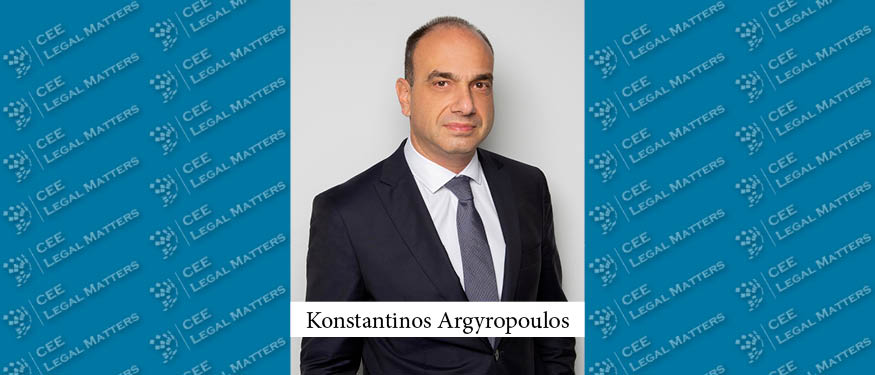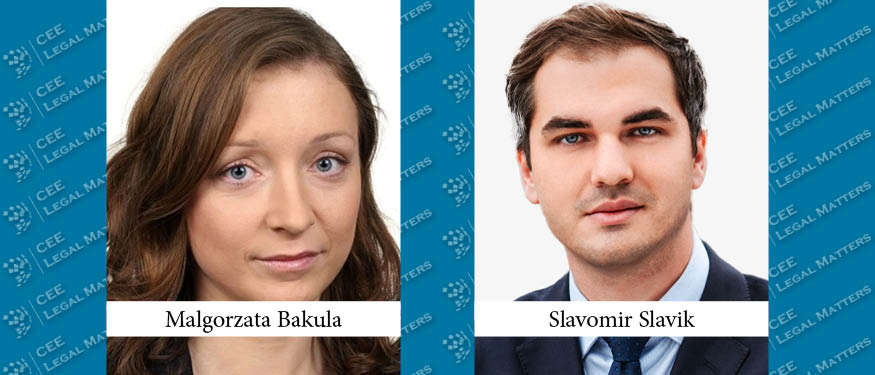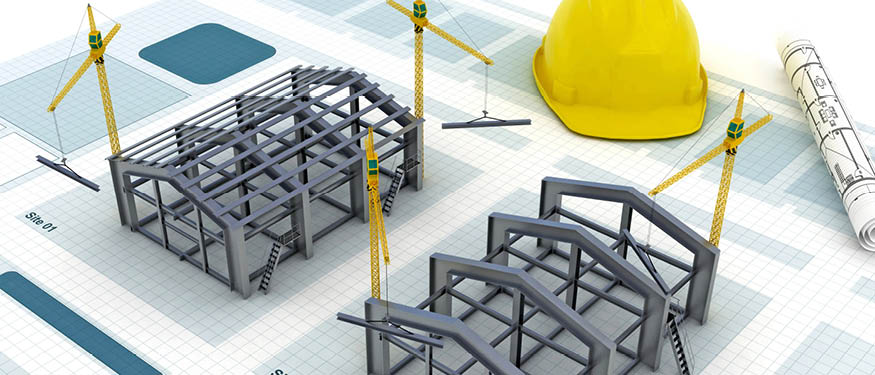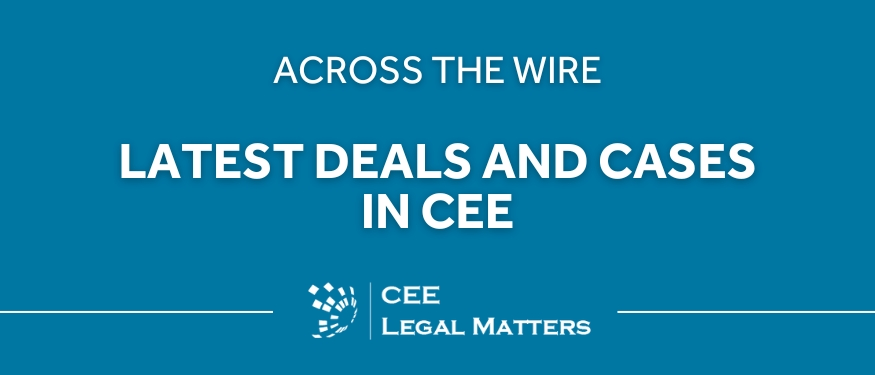CMS Partners Horea Popescu, Alexander Rakosi, and Ryszard Manteuffel discuss the ebb and flow of M&A deals in CEE, highlighting that the M&A landscape experienced a significant drop in overall deal values prompting strategic shifts amid ongoing geopolitical and financing challenges.
CEELM: Looking back at the past year, what were the most significant trends shaping M&A activity in CEE?
Popescu: I think it was a good year. We have seen an increase in transaction volume, but the last five years have averaged around 1,200 deals annually, indicating relative stability. While the number of deals stayed roughly the same, values dropped considerably – from around EUR 37 billion to EUR 25 billion – mainly due to fewer megadeals. In Poland and Romania, for example, there were no megadeals to impact the overall volume.
Regarding private equity, we saw exceptions, like the notable Pet Food deal, but in general large PE transactions were limited; it was mostly small- or mid-cap. Meanwhile, some larger exits seem to be on hold, waiting for better market conditions.
Rakosi: Horea’s perspective also fits the Balkan markets. Values were down, but activity levels remained solid. Private equity exits slowed, yet there was a stronger focus on add-on deals – an exit-prep tactic we expect to translate into proper exits in the next 12 to 18 months. PE still has capital to deploy, so it should pick up pace again soon. Some PE players judged last year as not ideal for exits and pivoted to refining their platforms for future sales. We also saw a rise in joint venture transactions, with competitors partnering on new product avenues – something we believe will continue.
Manteuffel: Poland didn’t record the same number of megadeals as before, but the volume of smaller deals was strong. Many investors remain cautious about the war’s repercussions and the overall shaky economic conditions, even if inflation is trending down. Still, there’s substantial potential waiting on the sidelines.
CEELM: How would you compare the current deal landscape to pre-war levels?
Popescu: In terms of the number of deals, we’re pretty much the same. Last year was probably the second worst in terms of values after 2020, which in itself was rather poor. However, our report does not cover the same countries as it did before – for example, we no longer cover Russia, and activity in Ukraine is naturally lower now. However, when we see that there is the same level of activity with these two markets not being part of the report, this indicates higher activity levels in the Balkans and the rest of the markets, which is positive overall.
CEELM: Which industries have been the most active in M&A transactions, and do you expect this trend to continue?
Popescu: Energy has been the standout, particularly in Romania and across CEE. Three of the four largest regional deals last year were energy-related, with two large deals totaling EUR 7 billion led by Czech investors CEZ and EPH. Distribution companies have been targeted, and though the number of renewable deals has slightly declined, a 600+ megawatt transaction with PPC in Romania shows that big deals are still happening. Overall, energy remained the star.
Rakosi: Aside from energy, infrastructure, data centers, and logistics were – and remain – key, especially in the Balkans. Healthcare has also been (and will continue to be) active, with assets like clinics/outpatient services centers changing hands. Moreover, circular economy areas – packaging and recycling – are drawing high attention.
Manteuffel: In Poland, according to our report real estate and construction were prominent, somewhat surprisingly so. Telecommunications, IT, banking, finance, and insurance were all active, while renewables saw a notable spike. Storage is emerging as part of green energy efforts. We’ve also seen significant life sciences activity – healthcare company consolidations and biotech developments.
CEELM: Are there any emerging sectors that investors should be watching?
Popescu: The sectors haven’t changed much overall, just year-to-year shifts – sometimes real estate spikes, sometimes energy. Manufacturing has historically been strong, but with the West flirting with recession, demand has dipped. I’d bet on technology, especially AI, to rebound, though data centers may be less appealing given energy costs. I still see healthcare, private schools, and retail reviving from basic consumer needs.
Rakosi: In industrial and manufacturing, we’re at a robotics crossover. While digitalization as a driver for M&A activity isn’t new, there’s a strong push to automate workflows and production processes and lessen workforce dependence.
Manteuffel: Poland’s strong IT sector is pivoting to AI across many companies. Investors keep an eye on how these transformations evolve, likely aiming for exits once the technology proves itself.
CEELM: What about M&A trends across different CEE countries? Are there any surprising developments in specific markets?
Popescu: The lack of megadeals in Poland was surprising. In Romania, there were no billion-euro transactions like in 2023, but plenty above the hundred-million mark. Romania’s catching up, and I expect other countries to follow.
Manteuffel: We just signed a PLN 1.2 billion deal and there are others in the pipeline, so I expect larger deals to make a comeback. I am an optimist. It does not seem too much use being anything else.
Rakosi: Balkan ticket sizes remain smaller compared to some other markets, but there’s optimism. Croatia, for instance, might get bigger deals in healthcare and retail, so I’d say cautious positive sentiment is justified.
CEELM: With financing becoming more expensive, how has this impacted deal structuring and valuations? Do you expect this impact to carry into 2025?
Rakosi: Financing clearly matters for M&A. PE players recalibrated valuations due to higher costs and/or volatile conditions, but those are now more predictable and less prohibitive. Still, big-ticket deals haven’t thrived, so many PE firms refocused on smaller or mid-market transactions. We also saw more regional PE houses stepping in, capturing deals that might’ve previously gone to larger international players. Ultimately, we feel that the market adapted to increased costs.
Manteuffel: I agree with Alexander, deals remain doable, despite higher financing costs. We’ve seen some structural tweaks – like minority investments and heavier reliance on earn-outs – but none of this significantly slowed M&A. Another trend is the rise of family offices, which rely less on external financing and thus have an edge over traditional PE.
CEELM: What are the biggest risks or uncertainties that could influence M&A activity in the region over the next year?
Popescu: Risks are mostly geopolitical, like US trade tariffs and the war in Ukraine. If the war ends, we still don’t know under what conditions. Inflation is down, which gives some predictability, but export-reliant countries could suffer if Western demand falls. In Romania, political turmoil and rising public debt could trigger a credit rating downgrade, impacting M&A, but – I remain hopeful.
Manteuffel: For Poland, geopolitics remains the main factor, especially the war. Also, energy prices pose real risks, even with green transition targets. High inflation and interest rates hinder companies’ growth, so that’s another concern.
Rakosi: I agree with both, those are the key risk elements to consider. For the Balkans, risk also remains tied to political stability issues and specific setups that differ from country to country. Foreign investment regimes can complicate multi-jurisdictional deals, but overall, it’s these geopolitical elements that are the real risks. Despite all that, however, I remain cautiously optimistic for the region still.
This article was originally published in Issue 12.2 of the CEE Legal Matters Magazine. If you would like to receive a hard copy of the magazine, you can subscribe here.

